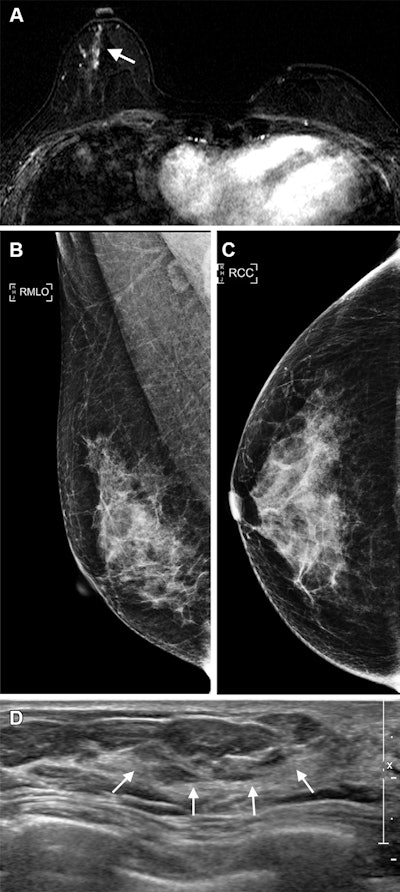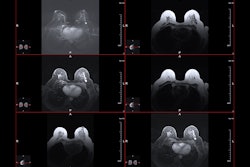Postoperative MRI surveillance appears to lower the odds of advanced second breast cancer in women with a personal history of the disease, researchers have reported.
"In women with a personal history of breast cancer, [we found that] postoperative surveillance breast MRI was associated with lower odds of advanced second breast cancer before and after propensity score matching," wrote a team led by Jiyoung Yoon, MD, PhD, of Yonsei University College of Medicine in Seoul. The group's study findings were published January 7 in Radiology.
 Images in a 40-year-old woman who underwent breast-conserving surgery for left breast cancer and a surveillance breast MRI examination 25 months after surgery. (A) Axial T1-weighted contrast-enhanced subtraction MRI scan shows a newly developed nonmass enhancement (arrow) in the right central breast. (B) The right mediolateral oblique (RMLO) and (C) right craniocaudal (RCC) mammograms, obtained on the same day, show heterogeneously dense breast tissue that was assessed as being negative for cancer. (D) MRI-directed US image in the radial plane shows a corresponding 14-mm nonmass lesion (arrows) in the right lower outer breast, which was confirmed estrogen receptor-positive, progesterone receptor–positive, and human epidermal growth factor receptor 2-negative T1N0 mucinous carcinoma. Image and caption courtesy of the RSNA.
Images in a 40-year-old woman who underwent breast-conserving surgery for left breast cancer and a surveillance breast MRI examination 25 months after surgery. (A) Axial T1-weighted contrast-enhanced subtraction MRI scan shows a newly developed nonmass enhancement (arrow) in the right central breast. (B) The right mediolateral oblique (RMLO) and (C) right craniocaudal (RCC) mammograms, obtained on the same day, show heterogeneously dense breast tissue that was assessed as being negative for cancer. (D) MRI-directed US image in the radial plane shows a corresponding 14-mm nonmass lesion (arrows) in the right lower outer breast, which was confirmed estrogen receptor-positive, progesterone receptor–positive, and human epidermal growth factor receptor 2-negative T1N0 mucinous carcinoma. Image and caption courtesy of the RSNA.
Women with a personal history of breast cancer are at higher risk for developing second breast cancers -- either local recurrences or new disease in the ipsilateral or contralateral breast, the authors explained. MRI demonstrates the highest sensitivity for detecting breast cancer compared with other imaging modalities and is recommended as a supplemental screening exam for women with a personal history of the disease or those with dense breast tissue. But research on the association between surveillance breast MRI in women with a personal history of breast cancer and advanced second breast cancer is lacking, they noted.
Yoon and colleagues conducted a study that investigated the association between postoperative surveillance breast MRI and advanced second breast cancer in women with a personal history of the disease using propensity score matching (this is a statistical method that balances the distribution of known biases and confounders between groups and thus achieves comparability similar to random assignment in a randomized trial).
The research included 3,688 women who underwent breast cancer surgery between January 2009 and December 2014. The team defined second breast cancer as ipsilateral or contralateral disease diagnosed at least one year after surgery; it defined advanced second breast cancer as second breast cancer as either grade T2 or higher or lymph node-positive or T1c triple-negative or human epidermal growth factor receptor 2-positive. Of the total patient cohort, 2,130 underwent postoperative surveillance breast MRI and 1,558 did not. The median interval between surgery and the first surveillance breast MRI was 31 months.
The authors reported the following:
- Advanced second breast cancer proportions for non-MRI and MRI groups were 1.7% and 0.4% before propensity score matching and 1.6% and 0.7% after it.
- Surveillance MRI was associated with lower odds of advanced second breast cancer before propensity score matching (odds ratio [OR], 0.21, p < 0.001) and after it (OR, 0.41, p = 0.048).
- The proportion of symptomatic second breast cancers was higher in the non-MRI group before propensity score matching (25% vs. 6.4%, p = 0.01) and after it (21% vs. 3.2%, p = 0.003).
The findings are promising, but more research is needed, according to the authors.
"Surveillance breast MRI has the potential to improve prognosis in women with a personal history of breast cancer … [but] further larger multicenter studies are necessary to validate these findings and assess their generalizability," they concluded.
The complete study can be found here.


.fFmgij6Hin.png?auto=compress%2Cformat&fit=crop&h=100&q=70&w=100)





.fFmgij6Hin.png?auto=compress%2Cformat&fit=crop&h=167&q=70&w=250)











